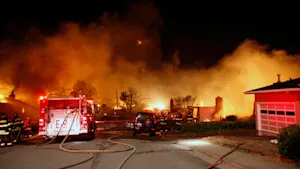More Stories
Stony Brook University gave an update on a nearly four-year study on how to prevent or limit flooding on the South Shore 10 years after Superstorm Sandy hit.
The Long Island Regional Planning Council discussed innovative ways to protect the vulnerable South Shore from flooding -- but it's not clear if any of the pricey projects will be approved.
The study looked at the feasibility of installing what are called sea gates across the inlets that dot Long Island's South Shore.
The idea behind them is that they could prevent ocean waters from surging into the bay during storms.
“Think of them as saloon doors in a bar, but they're mainly open. So the inlet's open 24 hours a day, 99.9% of the time. But if a big storm is predicted to arrive -- say a hurricane coming up the East Coast -- before the storm arrives, these gates can be closed,” says Malcolm Bowman, of Stony Brook University.
Various forms of sea gates are used in other places as close as Rhode Island and as far away as England, and even Russia.
“During Superstorm Sandy we had 3,800 homes flooded under 4-6 feet of saltwater,” says Freeport Mayor Robert Kennedy.
He says he hopes to never see damage like what Sandy brought to his village ever again. He'd love to see funding for sea gates in our area after visiting New Bedford, Massachusetts where surge barrier gates installed in 1960 have proven very effective.
“The city has never flooded since they installed these gates. They close them two hours before a named storm, they open them two hours after a named storm. We need to put up those surge barrier gates to protect the South Shore of Long Island and fortify the barrier island. That's what needs to be done here,” Kennedy says.
The study also looked at baffles, kind of folded walls that could be built in the bays to settle the water during storms, preventing them from flooding the shoreline.
Costs for these projects could be prohibitive, but experts say Long Island's flooding problems are only likely to get worse.
“The South Shore is vulnerable to rising sea levels and how much is the sea level going to rise by the end of the century? No one really knows. It could be 1 foot, 3 feet or worst case, 6 feet. That's a very serious problem,” Bowman says.
The study concluded that a combination of sea gates and baffles would have dramatically reduced the flooding and damage from the storm surge of Superstorm Sandy.
More from News 12
1:31

What's Cooking: Uncle Giuseppe's Marketplace's prime rib roast
1:27

What's Cooking: Uncle Giuseppe's quiche lorraine
2:34

Guide: Safety tips to help prevent home burglaries
2:19

Guide: Safety measures to help prevent fires and how to escape one
2:07

Tips on how to avoid confrontation with sharks while swimming in the ocean
2:33
